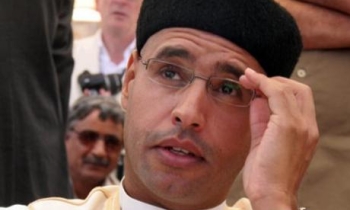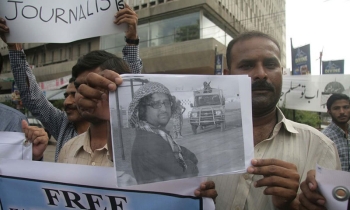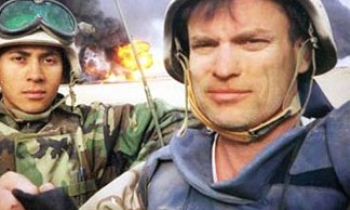As Iain Calder tells it triumphantly in The Untold Story, his memoir of thirty-three years at America’s best-selling supermarket tabloid, most of them at its helm, "The National Enquirer changed the face of American journalism." That journalism, which in his analysis had gotten "dull and gray," suddenly began to boil under the competitive pressures of the Enquirer. The press’s purview widened from information that editors thought the readers should know to salacious accounts that readers wanted to know. Newspapers, at least the once-respectable ones that he seems to believe were indistinguishable from one another, got personality. Perhaps most of all, virtually every newspaper, magazine, and television news broadcast now had a repertory company of protagonists – celebrities – whose romances, marriages, divorces, binges, escapades, peccadilloes, declines, dysfunctions, and pronouncements became a primary focus of the press. With a nod to Dwight Eisenhower, celebrity profiler Maureen Orth, in a new compilation of her articles, The Importance of Being Famous, calls this ever-expanding monolith the "celebrity-industrial complex."
Of course this is hardly revelatory. Everyone takes it for granted that American journalism has been "tabloidized," that once-taboo subjects are now grist for the journalistic mill and that celebrities are news, so much so that eventually the Enquirer’s circulation plummeted, presumably because it had lost its monopoly. Iain Calder isn’t particularly interested in why the press has undergone this transformation, but he is informative on how it occurred. Calder, who comes from a small coal-mining village in Scotland, was only sixteen and armed with a learning certificate awarded to students headed to trade school when he foundered his way onto a local paper as a way to meet girls. He soon graduated to a Glasgow tabloid at a time when a bare-knuckled newspaper war was roaring, and then to London where he manned the office of a marginal weekly American tabloid specializing in gore: The National Enquirer. He was so indefatigable in his pursuit of stories and stringers throughout Europe that he was invited to the headquarters in New York, eventually rising through the ranks to become the Enquirer’s executive editor in 1973 and officiating over the paper after it moved from horrifying accidents and disfigurements to celebrity foibles, and as its weekly circulation rose to five million.
Though Calder likes to credit the Enquirer and its publisher Gene Pope with having led the way to celebrity gossip, they were, in fact, tapping a very old wellspring that ran deep in the American psyche. Walter Winchell, the columnist who invented modern gossip in the 1920s and became its most famous practitioner, understood the powerful subtext of gossip as a form of empowerment. Having grown up poor, uneducated, and Jewish, essentially an outcast, he nursed deep resentments himself, and he realized that by exposing the rich, powerful, beautiful, and famous, he could draw on larger public resentments. Gossip was a form of democratization – a great leveler. It demonstrated that the celebrated were no better than the rest of us and sometimes much worse. Or, put another way, it allowed people to feel better about themselves by feeling worse about those who had so much more.
Calder may not have had the same insight as Winchell or any of Winchell’s personal antagonisms, but he did have the same populist instinct. Early on, the Enquirer began revealing secrets of the celebrated, especially television stars, whom fan magazines like Photoplay had regarded as insignificant. The Enquirer filled the breach, focusing on these people with whom readers already felt a sense of intimacy from the exposure on the small screen. At the same time that it was exploiting resentments by conducting its weekly journalistic strip searches, it also was encouraging hope, through features like "Rags to Riches" about poor individuals who managed to strike a lode, or bleeding heart stories about people in distress whom readers could help, or updates on the latest medical treatments that, it usually boasted, could improve your health or save your life, or its ever-present weight-loss regimens. It proved a powerful combination – showing the celebrated in extremis and the ordinary in triumph – and it played on American impulses of anger, as Winchell’s gossip did, but also of optimism. Lee Atwater, the late Republican strategist, read the Enquirer religiously and called it the "pulse of America."
But if Calder exploited the dynamic of resentment and hope, he also seems to understand something that not even Winchell did. Whatever its function, gossip is also a mentality and a process. The magpie mentality, which Calder may have picked up in his rough-and-tumble Glasgow days, is that in a secretive and deceptive world this celebrity trivia really matters, is almost life and death and has to be treated as such. Indeed, Calder grouses that the editor Larry Haley should have won the Pulitzer for finding photos that belied O.J. Simpson’s claim that he never owned the infamous Bruno Magli shoes, and the paper’s discovery that Simpson had purchased a knife shortly before his wife’s murder is called by another editor "one of the greatest pieces of reporting ever" – as if these tidbits were actually of great public import. It is probably what made him so good at what he did. He is so myopic about gossip, so devoid of any larger perspective, that he is oddly engaging if somewhat dotty, like someone who has devoted his entire life to making the world’s largest rubber-band ball. Still, in his single-minded devotion to celebrity flotsam and jetsam, Calder seemed to be at one with his readership and onto something, too. Enquiring minds did want to know, as the old TV ads said. They wanted to be the first to know. They had a vested interest in knowing, even if what they knew really wasn’t worth knowing and even if it wasn’t true. In a culture where there was so much to know, knowing what others might not know was itself a form of empowerment.
As for the process, the collection of gossip was of a piece with the gossip. Gossip was typically scorned by elites as unsavory and disreputable, something polite people did not consume, which, far from discouraging the public from reading gossip, may have been yet another engine for its popularity among the hoi polloi. To enjoy gossip was a way of tweaking the cultural commissars and establishing one’s own cultural independence. Certainly as far as the journalistic gossipmongers like Calder were concerned, if those who read gossip were thumbing their noses at moralists, gossip reporters were nose-thumbing more pompous and high-minded members of the press corps by violating every scruple of reputable journalistic practice, which is why the Enquirer so relished its chicanery and probably why readers cozied up to its outlaw status. Calder swaggeringly recounts stakeouts and chases and subterfuges that would put the CIA to shame, including insinuating one reporter into Lisa Marie Presley’s security detail so that he could snap a picture of Elvis’s first grandchild, and he tells of another reporter literally riffling through Henry Kissinger’s garbage. Then there are the bags of money that seem obligatory equipment for every Enquirer operation. Calder defends this checkbook journalism by saying that everyone does it, only the others furiously hide their tracks, yet one cannot help but detect a bit of pride in his buying sources, not only because it gets him the stories he wants but also because it is, in the eyes of the respectable press, ethically so wrong. Calder knew he was selling his readers resentment and hope. He was also selling them the paper’s own merry tawdriness.
When the mentality of obsessive disproportion combined with the process of skulduggery and underhandedness, the results could be deliciously Hechtian. Long before Howell Raines enjoined his New York Times staff to "flood the zone," Calder was sending nine reporters and photographers and twelve more stringers in Europe to Aristotle Onassis’s funeral, hoping to catch some sniping about Jackie’s seeming indifference. Twenty-five reporters covered Elvis’s funeral, at least fifty editors, reporters and researchers rushed to cover Grace Kelly’s death, and fifty-six were sicced on the story of Rock Hudson’s AIDS. As much as anything, it demonstrated how loony the celebrity apparatus had become, how much attention was being lavished on so little. There were more reporters on those stories than The Washington Post, the Los Angeles Times and The New York Times deployed on real news that affected people’s lives, but then the Enquirer at its peak sold more copies than those three papers combined. Some issues sold nearly twice as many.
In fact, if Calder’s book finally isn’t as sprightly or as rowdy or as much fun as it should be, it is because his lack of perspective frequently veers into preening hyperbole that the Enquirer would never have tolerated, except as one of its pretension-busting jokes. Again and again, Calder insists that the Enquirer staff is at the apex of journalism. The team ferreting out information on Grace Kelly is, in the words of one Enquirer reporter, the "best investigative team of journalists anybody had seen for a century." When, after Gene Pope’s death in 1988, the paper is sold to a group of venture capitalists, Calder writes that they bought the "best editorial investigative team of the twentieth century." Of Gene Pope, whom Calder worshipped, he writes that the publisher had "his standards, his drive for excellence" and a "manic mission to be the biggest and the best" without describing how any standard of excellence could possibly have fit the Enquirer and without saying the biggest and the best what.
Maureen Orth, a longtime special correspondent for Vanity Fair, works the other side of the celebrity tracks. Though both she and Calder trade in voyeurism, where he promotes resentment, she elicits envy, which is basically the difference between the Enquirer and Vanity Fair. Unlike Calder, Orth wrings her hands over what papers like the Enquirer have wrought and issues the typical string of indictments against the state of contemporary journalism. In today’s media we get a "lot less meaning and a lot less real product. Politics is often served up as scandal. News is more and more centered on the latest sensational drama. Stars edge out coverage of world events with breathless reports about their latest deals and endorsements." Blah, blah, blah. The Importance of Being Famous, containing Orth profiles of everyone from Margaret Thatcher to Madonna, from Vladimir Putin to Michael Jackson, purports to deconstruct the whole celebrity-industrial complex, and there are short introductions to the various sections that attempt to generalize about what celebrity means and how it operates, but in Orth’s hands the deconstruction looks exactly like the construction. Orth, who is married to Meet the Press’s Tim Russert, isn’t an antagonist to celebrity. She is a facilitator. And celebrity journalism, even the sordid sort practiced by Iain Calder, isn’t always adversarial. (Calder brags about letting Donald Trump vet pieces on him and tells how celebrities often rat on themselves just to get publicity.) It is usually collaborative. In any case, no one who profiles celebrities for Vanity Fair is going to pierce the celebrity veil. He or she would be fired. For Orth to think she’s doing anything but weaving that veil makes her as delusional as Calder thinking Gene Pope is another Sulzberger or Chandler.
Where Orth is on firmer ground is in recognizing that celebrity, like gossip, is more than mere entertainment or diversion – that it has a social/psychological function. Others, myself included, have discussed celebrity as a kind of art, providing narratives that reify themes and ideas in the culture much the way myths do. Her profile of Madonna speaks to the rage for personal reinvention. Her profile of Margaret Thatcher to the tragedy of losing celebrity and the bubble in which it envelops one. Her profile of Woody Allen to the self-deception of the famous and revered and the different moral rules to which they are held.
Certainly the best and longest celebrity narratives do have a mythic resonance. But the effect of Orth’s book is almost precisely the opposite of what she intended. Reading these pieces one after another, one is struck less by what they say about culture generally or even about celebrity specifically than by how little they say and how superficial it is. In fairness, this may not be so much the fault of Orth, who is observant and occasionally keen, as it is the fault of celebrity itself. One celebrity narrative sounds pretty much like another, one cautionary tale like another, one conclusion like another. Madonna, Margaret Thatcher, Woody Allen – it’s all the same. There is none of the heft and amplitude of real literature, none of the complexity. Celebrities exist to be accessible and easily digestible. As one of Orth’s own subjects, the designer Karl Lagerfeld, says of fashion, "Only the minute and the future are interesting in fashion – it exists to be destroyed." Celebrity is a lot like that. It is ephemeral. Its interest is entirely in the here and now. Some of the people in Orth’s book are already forgotten if they were ever known in the first place. Most of the others soon will be.
Yogi Berra once opined that you can’t think and hit at the same time. What Calder and Orth suggest is that you can’t think and write celebrity gossip or profiles at the same time and for the same reason. Thinking would inhibit the process, maybe destroy it altogether. The celebrity-industrial complex exists because there is a large public that finds tales of the beautiful, the powerful, and the wealthy entertaining and sometimes instructive in a home truth sort of way; because there are voracious media who need to satisfy the public taste in order to earn profits; because there is an ever-expanding universe of people who want and need to be in the public consciousness; and because there are journalists like Orth and Calder who can justify what it is they do as socially redeeming. It is a perfectly synergistic system. But it is not, as Iain Calder and Maureen Orth demonstrate in their own ways, a serious one. The real tragedy of celebrity is that most of the time it amounts to so little and, at least on the basis of these two books, leaves so little behind save cheap thrills.









